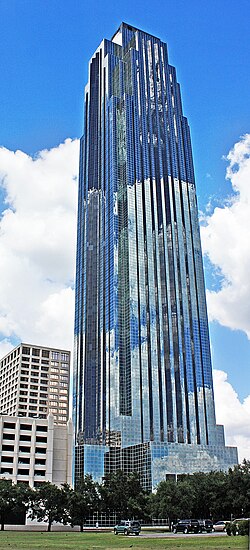Williams Tower
| Williams Tower | |
|---|---|

Williams Tower viewed from the street
|
|
| Former names | Transco Tower |
| General information | |
| Status | Complete |
| Type | Office tower |
| Architectural style | Post-modern |
| Address | 2800 Post Oak Boulevard |
| Town or city | Houston, Texas |
| Country | United States |
| Coordinates | 29°44′14″N 95°27′41″W / 29.73722°N 95.46139°WCoordinates: 29°44′14″N 95°27′41″W / 29.73722°N 95.46139°W |
| Current tenants |
Williams Companies Quanta Services Rowan Companies Cadence Bancorp Hines Interests |
| Groundbreaking | August, 1981 |
| Completed | Between December 1982 and January 1983 |
| Opened | 1983 |
| Cost | US$300 million |
| Owner | Invesco Advisers Inc. |
| Landlord | Hines |
| Height | |
| Roof | 275 m (902 ft) |
| Technical details | |
| Floor count | 64 |
| Floor area | 1,483,308 sq ft (137,803.8 m2) |
| Lifts/elevators | 49 |
| Design and construction | |
| Architecture firm | John Burgee Architects with Philip Johnson and Morris-Aubry Architects |
| Structural engineer | CBM Engineers Inc. |
| Main contractor | J.A. Jones Construction Co. |
| Website | |
| williamstower |
|
| References | |
The Williams Tower (originally named the Transco Tower) is a 64-story, 1.4-million-square-foot (130×103 m2) class A office tower located in the Uptown District of Houston, Texas. The building was designed by New York-based John Burgee Architects with Philip Johnson in association with Houston-based Morris-Aubry Architects (now known as Morris Architects). Construction began in August, 1981 and was completed in December, 1982. The tower is among Houston's most visible buildings and is the 4th-tallest in Texas, the 31st-tallest in the United States, and the 140th-tallest building in the world. The Williams Tower is the tallest building in Houston outside of Downtown Houston, and at the time of its construction was believed to be the world's tallest skyscraper outside of a central business district.
Real estate developers Gerald D. Hines Interests hired New York-based John Burgee Architects with Philip Johnson to design the building, in association with Houston-based Morris-Aubry Architects (now known as Morris Architects).
Construction was completed in 1983.
The building was named the Transco Tower after its first major tenant, Transco Energy Co. Transco Energy Co. merged with the Williams Companies in 1995 and in 1999 the name of the building was changed to the Williams Tower.
In December 2002, Ryan John Hartley climbed the tower and jumped from about halfway up, resulting in his death, which was ruled a suicide.
In 2008, Hines REIT Properties LP, an affiliate of Hines Real Estate Investment Trust Inc., purchased the Williams Tower for $271.5 million from Transco Tower Ltd., a partnership consisting of Kuwaiti investors represented by Atlanta-based Fosterlane Management Corp. The building was offered along with a parking garage, a 2.3-acre (0.93 ha) tract across the street from the Williams Tower, and a 48% stake in the Williams Waterwall (now named the Gerald D. Hines Waterwall Park) and the surrounding park; prior to this transaction Hines had already owned the other 52% of the waterwall.
...
Wikipedia
